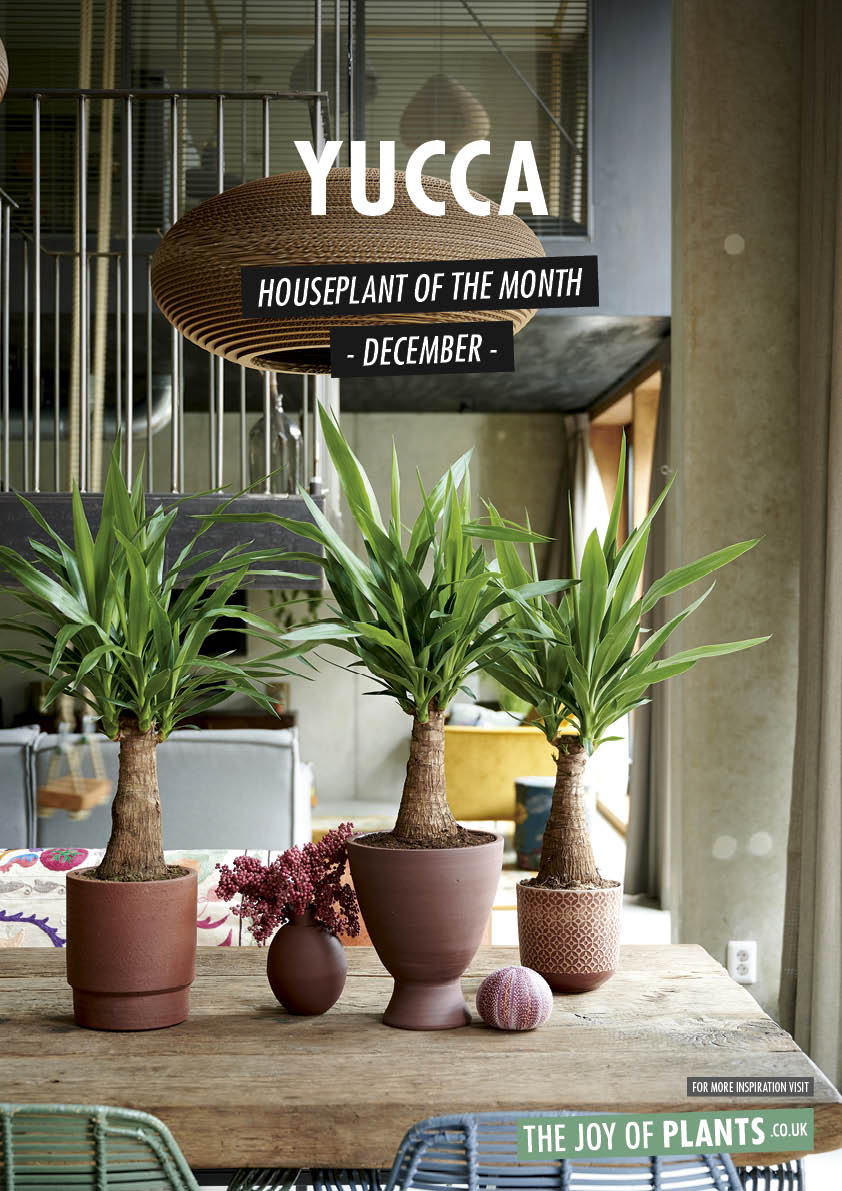Yucca: Houseplant of the Month December 2020
The story of the Yucca
The Yucca is a member of the agave family (Agavaceae) which also includes houseplants such as Dracaena, Beaucarnea and Cordyline. In the wild the Yucca grows in hot dry regions in North and South America and the Caribbean. The plants often have thick, leathery leaves with a sharp tip and white flowers. These leaves grow straight out of the soil or on one or more stems.
Origin of the Yucca
The Yucca stems are imported from South America, where the plants grow on coffee plantations providing shade for the coffee plants. Yuccas grow about 30cm a year, and are pruned after a number of years. The pruned material is then potted in Europe, and after the leaf rosettes have formed the Yucca can be sold as a houseplant.
 What to look for when buying Yucca
What to look for when buying Yucca
- Dimensions: Particular check that the pot size is correct in relation to the number of heads per stem or stems per pot, the shape of stem, the height of the plant and the age of the plant.
- Growth habits: The Yucca is sold in many different growth habits: single stem, top cutting, tuft (several plants of one species in a single pot), branched (two or more sidebranches on the main stem), with underplanting, stump or mummies.
- Roots: With stem products such as Yucca it is particularly important to check for good roots.
- Leaf tips: There should be no leaf tip damage from knocks that extends more than 5 mm.
- Health: The plant must be healthy, free of pests and diseases. Particularly look for mealybug and scale insects and possible banana root borers or banana moths in the stems.
- Stem head: The head of the stem must be sealed with wax in order to prevent rot caused by moisture or water penetration.
Yucca range
The Yucca range is fairly limited. The most commonly sold species is the green-leafed Yucca elephantipes, named after an elephant’s foot, which the Yucca strongly resembles in natural conditions. Alongside the elephantipes species, Y. aloifolia and T. rostrata are also common, and in the garden we see Y. flaccida. There are also Yuccas where the leaf has pale edges, such as the Yucca elephantipes ‘Jewel’.
Care tips for customers
The bigger and thicker the stem the easier the plant is to look after.
- Yucca needs a light position and requires regular watering - but not too much, since that can cause the stem to rot.
- The Yucca can also be placed outdoors in a sunny spot between May and October. Allow the plant to acclimatise to the sun in order to prevent scorching.
- During the hibernation period in winter the plant can be placed in a cool spot and will then require less water.
- Yellow or unsightly leaves can be removed. The Yucca can even be pruned, preferably during the winter months.
- The plant may flower, particularly if it is somewhat ‘neglected’.
Display and sale tips for Yuccas
Its strong shape and easy to care for makes the Yucca an ideal plant for those who lack green fingers (even students), preferably in a rugged stone pot. To make the plant utterly trendy and ‘happy life’ boho chic, the Yucca can be placed in a colourful ‘folklore’ style pot. The ethnic patterns can even be continued on the stem and the leaf rosette using natural paint.
Images of the Yucca
You can download and use the images below free of charge if you credit Thejoyofplants.co.uk.
Instagram: @thejoyofplants
Facebook: @thejoyofplants
Twitter: @thejoyofplants
Yucca posters
You can download the posters using the links below.

